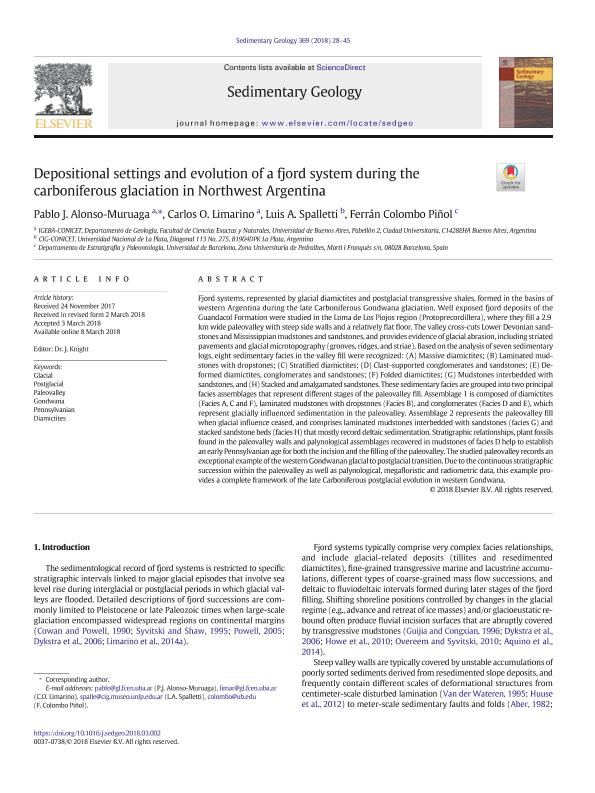Mostrar el registro sencillo del ítem
dc.contributor.author
Alonso Muruaga, Pablo Joaquin

dc.contributor.author
Limarino, Carlos Oscar

dc.contributor.author
Spalletti, Luis Antonio

dc.contributor.author
Colombo Piñol, Ferran

dc.date.available
2019-08-09T21:52:16Z
dc.date.issued
2018-07
dc.identifier.citation
Alonso Muruaga, Pablo Joaquin; Limarino, Carlos Oscar; Spalletti, Luis Antonio; Colombo Piñol, Ferran; Depositional settings and evolution of a fjord system during the carboniferous glaciation in Northwest Argentina; Elsevier Science; Sedimentary Geology; 369; 7-2018; 28-45
dc.identifier.issn
0037-0738
dc.identifier.uri
http://hdl.handle.net/11336/81371
dc.description.abstract
Fjord systems, represented by glacial diamictites and postglacial transgressive shales, formed in the basins of western Argentina during the late Carboniferous Gondwana glaciation. Well exposed fjord deposits of the Guandacol Formation were studied in the Loma de Los Piojos region (Protoprecordillera), where they fill a 2.9 km wide paleovalley with steep side walls and a relatively flat floor. The valley cross-cuts Lower Devonian sandstones and Mississippian mudstones and sandstones, and provides evidence of glacial abrasion, including striated pavements and glacial microtopography (grooves, ridges, and striae). Based on the analysis of seven sedimentary logs, eight sedimentary facies in the valley fill were recognized: (A) Massive diamictites; (B) Laminated mudstones with dropstones; (C) Stratified diamictites; (D) Clast-supported conglomerates and sandstones; (E) Deformed diamictites, conglomerates and sandstones; (F) Folded diamictites; (G) Mudstones interbedded with sandstones, and (H) Stacked and amalgamated sandstones. These sedimentary facies are grouped into two principal facies assemblages that represent different stages of the paleovalley fill. Assemblage 1 is composed of diamictites (Facies A, C and F), laminated mudstones with dropstones (Facies B), and conglomerates (Facies D and E), which represent glacially influenced sedimentation in the paleovalley. Assemblage 2 represents the paleovalley fill when glacial influence ceased, and comprises laminated mudstones interbedded with sandstones (facies G) and stacked sandstone beds (facies H) that mostly record deltaic sedimentation. Stratigraphic relationships, plant fossils found in the paleovalley walls and palynological assemblages recovered in mudstones of facies D help to establish an early Pennsylvanian age for both the incision and the filling of the paleovalley. The studied paleovalley records an exceptional example of the western Gondwanan glacial to postglacial transition. Due to the continuous stratigraphic succession within the paleovalley as well as palynological, megafloristic and radiometric data, this example provides a complete framework of the late Carboniferous postglacial evolution in western Gondwana.
dc.format
application/pdf
dc.language.iso
eng
dc.publisher
Elsevier Science

dc.rights
info:eu-repo/semantics/openAccess
dc.rights.uri
https://creativecommons.org/licenses/by-nc-sa/2.5/ar/
dc.subject
Diamictites
dc.subject
Glacial
dc.subject
Gondwana
dc.subject
Paleovalley
dc.subject
Pennsylvanian
dc.subject
Postglacial
dc.subject.classification
Geología

dc.subject.classification
Ciencias de la Tierra y relacionadas con el Medio Ambiente

dc.subject.classification
CIENCIAS NATURALES Y EXACTAS

dc.title
Depositional settings and evolution of a fjord system during the carboniferous glaciation in Northwest Argentina
dc.type
info:eu-repo/semantics/article
dc.type
info:ar-repo/semantics/artículo
dc.type
info:eu-repo/semantics/publishedVersion
dc.date.updated
2019-07-24T18:04:22Z
dc.journal.volume
369
dc.journal.pagination
28-45
dc.journal.pais
Países Bajos

dc.journal.ciudad
Amsterdam
dc.description.fil
Fil: Alonso Muruaga, Pablo Joaquin. Consejo Nacional de Investigaciones Científicas y Técnicas. Oficina de Coordinación Administrativa Ciudad Universitaria. Instituto de Geociencias Básicas, Aplicadas y Ambientales de Buenos Aires. Universidad de Buenos Aires. Facultad de Ciencias Exactas y Naturales. Instituto de Geociencias Básicas, Aplicadas y Ambientales de Buenos Aires; Argentina. Universidad de Buenos Aires. Facultad de Ciencias Exactas y Naturales. Departamento de Geología; Argentina
dc.description.fil
Fil: Limarino, Carlos Oscar. Consejo Nacional de Investigaciones Científicas y Técnicas. Oficina de Coordinación Administrativa Ciudad Universitaria. Instituto de Geociencias Básicas, Aplicadas y Ambientales de Buenos Aires. Universidad de Buenos Aires. Facultad de Ciencias Exactas y Naturales. Instituto de Geociencias Básicas, Aplicadas y Ambientales de Buenos Aires; Argentina. Universidad de Buenos Aires. Facultad de Ciencias Exactas y Naturales. Departamento de Geología; Argentina
dc.description.fil
Fil: Spalletti, Luis Antonio. Consejo Nacional de Investigaciones Científicas y Técnicas. Centro Científico Tecnológico Conicet - La Plata. Centro de Investigaciones Geológicas. Universidad Nacional de La Plata. Facultad de Ciencias Naturales y Museo. Centro de Investigaciones Geológicas; Argentina
dc.description.fil
Fil: Colombo Piñol, Ferran. Universidad de Barcelona; España
dc.journal.title
Sedimentary Geology

dc.relation.alternativeid
info:eu-repo/semantics/altIdentifier/url/https://www.sciencedirect.com/science/article/pii/S0037073818300423
dc.relation.alternativeid
info:eu-repo/semantics/altIdentifier/doi/http://dx.doi.org/10.1016/j.sedgeo.2018.03.002
Archivos asociados
